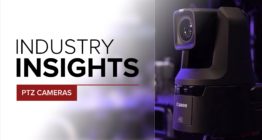Industry Insights: Studio cameras focus on connectivity, formats

Subscribe to NCS for the latest news, project case studies and product announcements in broadcast technology, creative design and engineering delivered to your inbox.
The rapid move to remote production and a variety of evolving formats have left broadcasters with many options for studio cameras.
In this installment of our Industry Insights roundtable, our experts from the field of broadcast cameras discuss studio cameras and how they fit into production.
Make sure to check out our other roundtable installment which looks at PTZ cameras.
Have you seen the adoption of 4K/UHD, HDR, or other leading-edge technologies from your customers? How are they doing it?
“We have seen the adoption of 4K among our customers and have found that their usage falls into several groups. Some are 4K ready and HDR ready for the purposes of future-proofing and providing a maximum ROI, but with no immediate plans to implement 4K. We’re seeing 4K being used on some special sports channels through satellite, cable and streaming. For OB live events, 4K supports image magnification for large LED board and it’s being implemented for archival recordings purposes and streaming purchases,” said Rob Willox, a media solutions marketing director for Sony Electronics.
“Current ATSC broadcast standards prevent terrestrial TV stations from taking advantage of full HD (1080p), 4K/UHD or HDR. ATSC 3.0 will allow these improvements to be implemented for broadcast stations, so forward-looking customers are starting to plan ahead. Customers in other segments of the market or with other delivery mechanisms, such as cable programmers and mobile sports production, are not limited by ATSC so are already adopting these technologies,” said John Humphrey, Hitachi Kokusai Electric America’s VP of business development.
“There’s no doubt about the value of 4K, as there’s been a big move toward 4K for public spaces, sports arenas, concert venues and the like. From the broadcast perspective, content owners are seeking opportunities to capture 4K, 8K, and HDR content, so they can not only offer content for the regular telecast, but premium as well. It’s also become very popular for studios and sets to install LED walls behind the host desk and feed high quality, engaging visuals to that wall, which is a very good application of 4K,” said Mike Bergeron, senior product manager, Live Production at Panasonic USA.
“The rate of adoption is very dependent on market conditions in different regions. We see customers producing in both 4K/UHD and the various HDR formats, or BT.2020 wide color gamut – other customers are using only parts of these formats. For example, production in 1080p with HDR and WCG is a typical application in some markets, while 4K/UHD in SDR is used in other markets,” answered Klaus Weber, principal of camera solutions and technology for Grass Valley.
“In HDR, depending on the transmission standards deployed by the end-user, we see demands for productions in each of the known HDR formats. Therefore, what customers need from us is a flexible solution that can support all the known HDR formats in the best possible way – in other words native HDR,” said Weber.
“HDR is being adopted by specialty cable and satellite channels for sports and live events, as well as some streaming platforms. As the workflow for HDR becomes more streamlined, side-by-side production is becoming easier to accomplish. In order to control costs, we’re finding HD HDR is a popular option,” added Willox.
“At Blackmagic Design, we always strive to offer the highest quality, most cutting-edge technologies to our customers, which is why we’ve been incorporating 4K/UHD and HDR capabilities in our gear for many years now across product lines. It’s allowed broadcasters the flexibility of being able to work in HD but have UHD capability when the time comes or access to HDR as the need arises,” said Bob Caniglia, director of sales operations in North America for Blackmagic Design.
“We’ve seen the rapid adoption of this technology from our customers, and it’s amazing to see how, on a global level, our customers leverage our solutions for projects across disciplines,” added Caniglia.
What is driving studio camera upgrades? Normal cycles? Move to IP? New production formats?
“Studio camera upgrades are often driven by a facility refresh, a location change or a new NOC and can provide an enhanced viewer or fan experience. Unsurprisingly, remote production is gaining traction and becoming an industry standard. We’re also seeing the adoption of 8x Supermotion among OB vans, as well as remote-controlled high-end box cameras for robotics. Additionally, the migration to ST 2110 IP environments is officially underway,” Willox said.
“We have experienced two major reasons for our customers to purchase new studio cameras. Industry professionals want to keep up with the latest technology, so they continue to look to upgrade their existing systems to JVC’s latest product offerings. We have also seen a significant implementation of our IP streaming studio systems, which are glass-to-glass turnkey solutions for a variety of applications, such as live sports and events,” said Craig Yanagi, JVC Professional Video’s national marketing manager.
“Almost all TV stations have already upgraded to HD cameras in the news studio but, as above, most are not yet ready for 4K. The higher sensitivity and lower noise offered by newer cameras allow lowered studio lights, which helps the on-camera talent, while global shutter technology enables superior image acquisition in today’s studios that incorporate a lot of LED displays and lighting. The latest generation of cameras also includes 1080p and simultaneous SDR and HDR output, but the move to IP can often be addressed on existing cameras simply by replacing the corresponding camera control unit (CCU),” said Humphrey.
“The ability to do 1080P has shifted from a ‘nice-to-have’ for future-proofing to being a prerequisite for broadcast. New production formats are driving the need to upgrade to 1080P and 4K. In response to today’s changing environment, it’s become a greater focus to build more virtual studios, so studio cameras are evolving to meet those demands as well,” said Bergeron.
“The need to operate new production formats is very often an important reason to invest in newer, more flexible camera technology. Increasingly, our customers also tell us they need to be able to work in any of the possible formats upon request. As the transition to IP infrastructures becomes more widespread, this can drive the need for investments in newer camera technology that can connect directly into IP networks. This type of direct native camera connection to IP infrastructures enables new and better REMI workflows and is, therefore, an increasingly important factor for our customers. Then there are the customers who invest in new camera systems as part of their typical investment cycles,” Weber said.
“During COVID-19, many broadcasters adjusted their workflows to thrive in remote environments and have invested substantial time and resources into this. Broadcasters needed professional but portable solutions that could be used from home or in the studio,” Caniglia noted.
How do you see the move towards IP and automation continuing to change or impact studio cameras?
“IP helps manage costs and achieve greater efficiencies in production without compromising quality, generates higher productivity by transforming workflows for better collaboration and provides better utilization of production resources through the sharing of equipment, facilities and staff across locations. We expect technology prices to decrease once operations transition to full IP environments, as opposed to hybrid SDI. Additionally, the move to IP will continue to increase as the interconnectivity between vendors improves,” said Deon Le Cointe, senior manager of IP and sports for Sony.
“We see the move towards IP infrastructure to be an integral part of futureproofing studio systems. In fact, JVC has implemented IP technology throughout our product spectrum. From the industry’s most affordable streaming camcorder to our flagship fiber studio system, JVC has been leading the IP solutions market since 2016,” Yanagi said.
“The move to ‘media over IP’ (ST 2110 and NDI) inside the news studio itself has been fairly limited so far, but as noted above, can often be addressed with changes to the camera control unit (CCU) rather than the camera itself. However, news control rooms and playout operations have been transitioning to robotic cameras and automated news operations for years. This trend will continue to accelerate as these systems mature,” Humphrey predicted.
“The move towards IP infrastructures, combined with the increasing drive towards flexible, decentralized productions, will lead to greater flexibility in the bandwidth requirements of the cameras. While the available bandwidth of local IP networks typically allows uncompressed operation of the cameras, data compression will play an important role when wide area networks are used for an array of decentralized productions,” said Weber.
“Depending on the available IP bandwidth and also on the required production formats, different compression rates have to be supported. Many users would like to see greater automation of studio cameras. Still, at present, the high demands on image quality can only be met by manual scene- and light-dependent camera control. However, the latest camera control solutions have already been optimized to the point where users can realize the best possible results with minimal time and manpower,” Weber added.
“In order to build a fully functional virtual studio, automation is a great driving force to the upgrade of studio cameras, which is fueling a continuing trend of integrating studio cameras with robotic systems. The addition of tracking systems to camera rigs to incorporate elements like AR and 3D graphics is moving into more markets to create new and more compelling content. While these are all generally supported by IP connectivity, I wouldn’t say IP is driving studio camera upgrades yet, since these cameras are designed to be run by in person operators, but I think you’ll see IP having a much bigger impact in the next generation of cameras as IP infrastructure is becoming more widespread and brings more workflow options,” said Bergeron.
Any workflow enhancements coming to studio cameras?
“Over the past few years, we have witnessed a rise in the implementation of technologies that increase IP stream resiliency. JVC pioneered this initiative by including ZiXi signal error correction technology into our products at an early stage. Most recently, we have been working with Haivision to incorporate its SRT technology into JVC’s latest top tier products to ensure our customers are ahead of the implementation curve,” said Yanagi.
“Camera robotics have been employed for years, but the use of simple PTZ or POV cameras – as well as robotic camera pedestals – continues to increase. The camera setup has also become increasingly automatic, saving time while ensuring picture consistency and stability for day-to-day operations,” Humphrey said.
“The ability to purchase an affordable camera today that can easily be upgraded to 4k in the future is allowing studios to enhance their workflows and offer more productions – in 4K and HDR – while having a camera that meets their immediate needs and can evolve with them. Additionally, the ability to support a cinema workflow with studio camera technology allows multi-camera productions by using the lenses of broadcast cameras and undergoing the same post-process for cinema production. Also, there is a special optical filter to eliminate artifacts when filming LED background walls, so operators can take advantage of a 4K image while filtering out the highest details which can become problematic with the LED imaging,” said Bergeron.
“The improvement of workflows is a continuous process and besides the developments already mentioned that result from a native connection to IP infrastructures, advances in camera control are especially worth mentioning. Highly customizable camera control panels with a new graphical representation of all setting parameters on a practically unlimited number of mobile display devices opens up new image control possibilities. In addition, for better and faster optimization of image quality, settings can also be made simultaneously – away from the camera control room. This enables both improved decentralized productions and easier communication between the various operators involved in managing optimized image settings for the production,” Weber explained.
“Maintaining excellent production value while prioritizing safety and social distancing has become a big concern. Whether in the studio or at home, broadcasters need flexible cameras that can provide professional studio camera features regardless if they are purpose-built for this use case or updated to adapt to the requirements of today’s workflows. Broadcasters need to control and monitor their gear from a healthy distance without sacrificing quality and efficiency,” Caniglia said.
Participants
Rob Willox and Deon Le Cointe, Sony Electronics
Craig Yanagi, JVC Professional Video
John Humphrey, Hitachi Kokusai Electric America
Klaus Weber, Grass Valley
Bob Caniglia, Blackmagic Design
Mike Bergeron, Panasonic
Subscribe to NCS for the latest news, project case studies and product announcements in broadcast technology, creative design and engineering delivered to your inbox.









tags
4K Broadcasting, 4K Television, Blackmagic Design, Bob Caniglia, Camera, Cameras, Craig Yanagi, Deon LeCointe, Grass Valley, hdr, Hitachi, John Humphrey, JVC, Klaus Weber, Mike Bergeron, panasonic, Rob Willox, Robotic Camera Control, robotic cameras, Sony, TV Studio Cameras, UHD, Zixi
categories
4K, HDR and UHD Broadcasting, Broadcast Equipment, Camera Control & Camera Robotics, Cameras, Featured, Industry Insights, IP Based Production, Voices